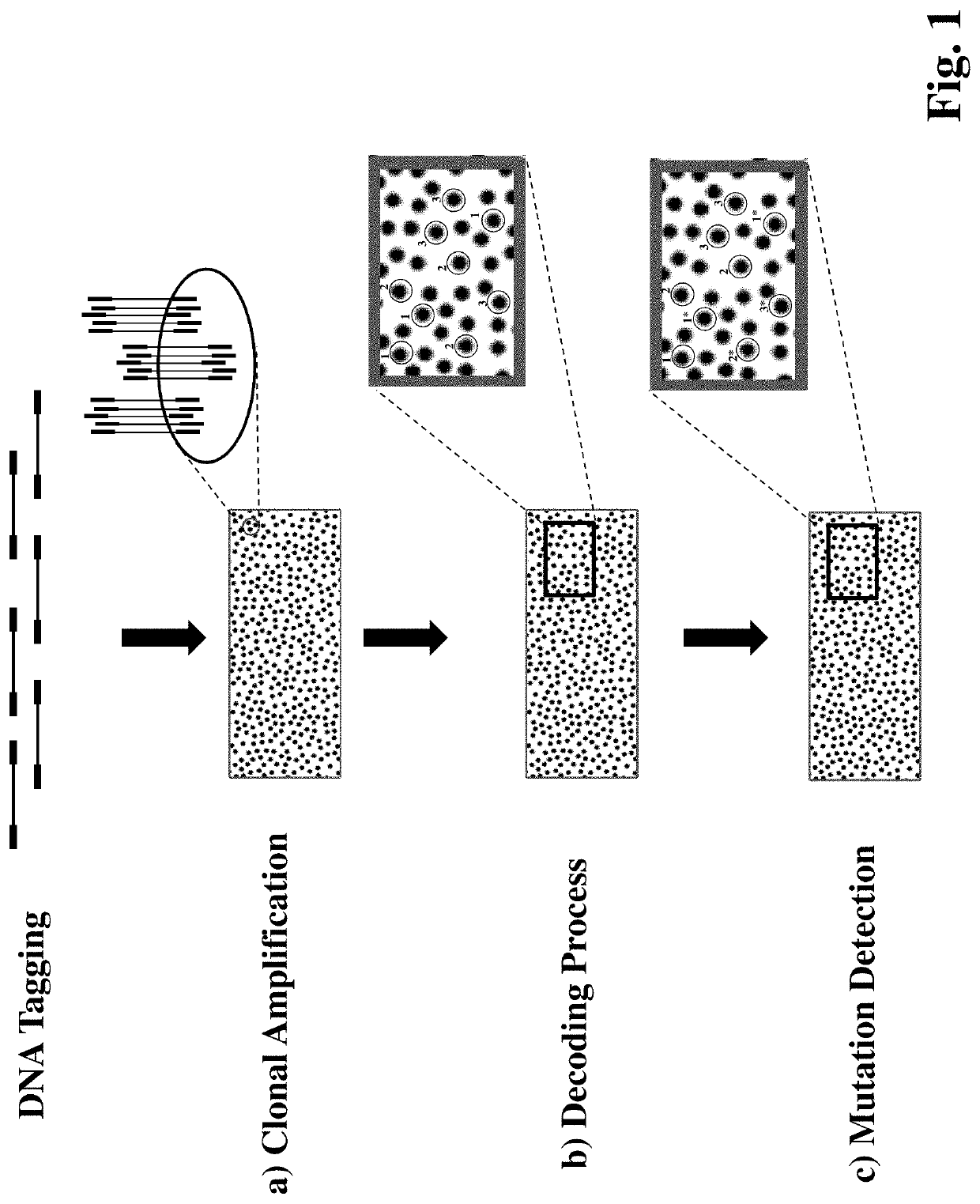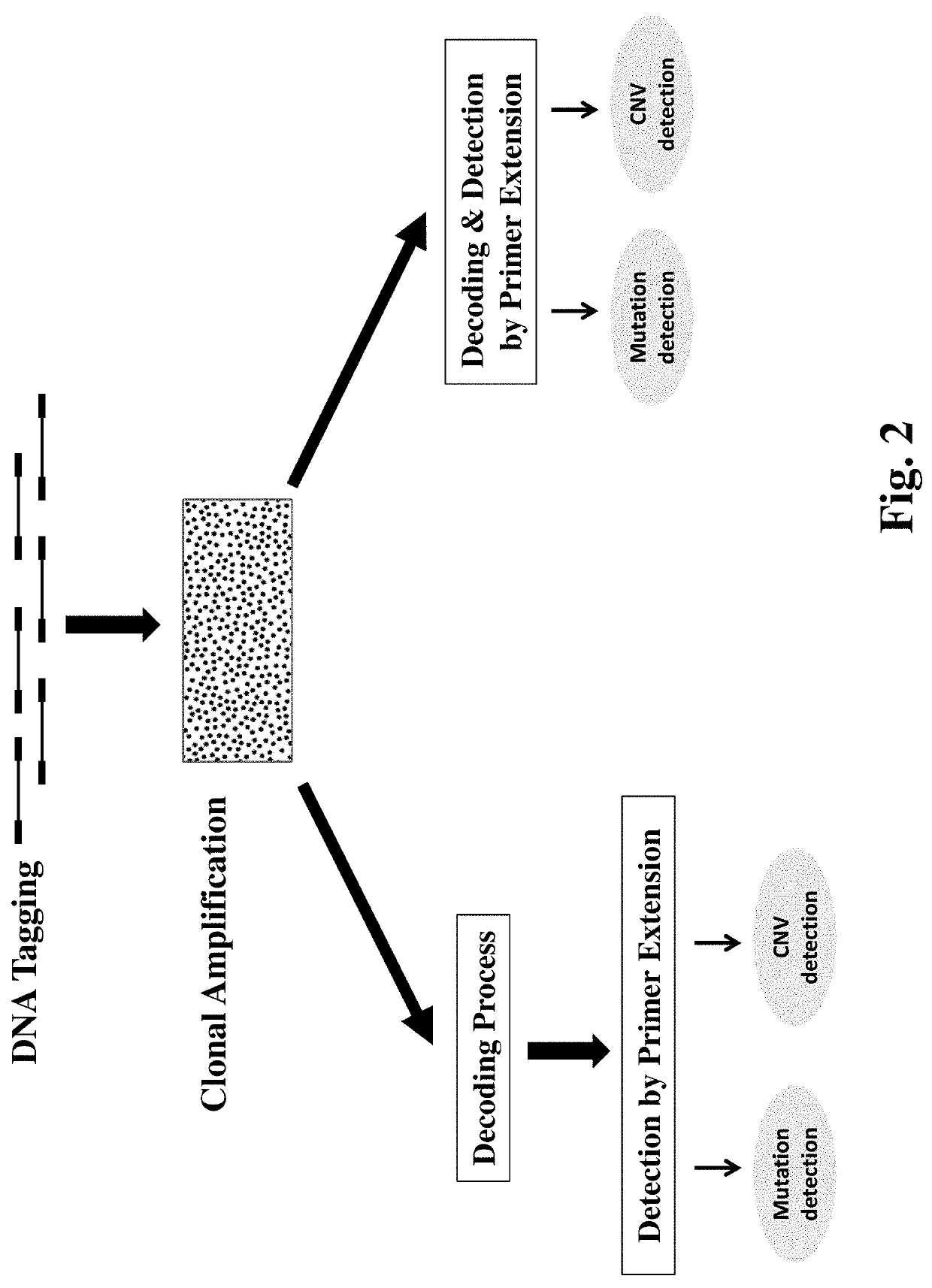Multiplexed Method for Detecting DNA Mutations and Copy Number Variations
a multi-method, dna technology, applied in the field of biotechnology, can solve the problems of low specificity, low sensitivity of the probe, limited starting materials in clinical samples, etc., and achieve the effect of reducing error rate and easy detection
- Summary
- Abstract
- Description
- Claims
- Application Information
AI Technical Summary
Benefits of technology
Problems solved by technology
Method used
Image
Examples
examples
[0120]The invention is further illustrated in more details with reference to the accompanying examples. It is noted that, the following embodiments are only intended for purposes of illustration and are not intended to limit the scope of the invention.
experiment 1
Detection of Fifty Somatic Mutations in a Cell-Free Circulating DNA Sample
[0121]This example demonstrates how to use the invented method to detect multiple somatic mutations in cell-free circulating DNA (cfNA) samples.
[0122]Preparation of Decoder Sequences and Mutation Detection Primers
[0123]Before starting testing the sample, design 50 mutation detection primers with 3′ end having at least one mutated nucleotide and 50 decoder sequences that overlap with the mutation detection primer at 5′ sequences without the 3′ mutated nucleotides. The decoder sequence is either labeled with a red or a green fluorescence label. The length of mutation detection primers is 20 to 25 nt.
[0124]DNA Extraction and Tagging
[0125]A cfDNA sample is extracted from a patient's blood using a commercially available extraction kit such as MagMAX Cell-Free DNA Isolation Kit (Thermo Fisher Scientific, Waltham, Mass.) and QIAamp circulating nucleic acid kit (Qiagen, Valencia, Calif.).
[0126]A double-tagged DNA prep...
experiment 2
Detection of 200 Genomic Mutation Sequences Using a Detection by Extension Decoding Method
[0134]This method demonstrates how to simultaneously measure 200 genomic mutations using a detection by extension decoding method.
[0135]Design and prepare 200 decoder sequences specific for mutant sequences and 200 decoder sequences specific for the corresponding wild-type sequences of target sequences.
[0136]Prepare DNA samples use a genomic DNA preparation kit and perform clonal amplification to make DNA clusters as described in Example 1.
[0137]Perform the decoding process to identify DNA clusters containing a mutant target sequence or a wild-type target sequence using the 400 decoder sequences above. The decoding process uses the presence (value:1) and absence (value: 0) of decoder sequences as two labeling states. The minimum number of decoding hybridizations needed is 9 ([log2400]). To examine the accuracy of the decoding result, add a 10th hybridization to test if the decoded assignment of...
PUM
| Property | Measurement | Unit |
|---|---|---|
| length | aaaaa | aaaaa |
| drug resistance | aaaaa | aaaaa |
| frequency | aaaaa | aaaaa |
Abstract
Description
Claims
Application Information
 Login to View More
Login to View More - R&D
- Intellectual Property
- Life Sciences
- Materials
- Tech Scout
- Unparalleled Data Quality
- Higher Quality Content
- 60% Fewer Hallucinations
Browse by: Latest US Patents, China's latest patents, Technical Efficacy Thesaurus, Application Domain, Technology Topic, Popular Technical Reports.
© 2025 PatSnap. All rights reserved.Legal|Privacy policy|Modern Slavery Act Transparency Statement|Sitemap|About US| Contact US: help@patsnap.com


